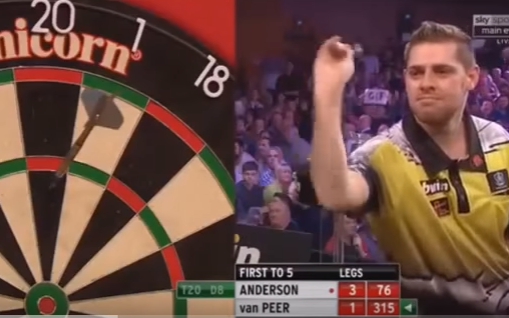Dartitis: The affliction all darts players fear ahead of World Championships

Berry van Peer’s eyes filled with tears and his jaw trembled with the strain of holding them back. He strode to the oche, leaned towards the board and cocked his throwing arm in the same motion that he had performed thousands upon thousands of times before. But he couldn’t let go. The dart remained firmly enclosed in his fingers, and his arm fell back to his side.
After four or five attempts, it finally escaped his hand, with the second and third darts flying out in quick succession. The affliction remained, though, and Van Peer’s struggles continued through the final leg of his defeat by Gary Anderson in last month’s Grand Slam of Darts.
The footage makes for agonising viewing. The first inclination, upon watching it, is to bellow at the screen. Just throw it, man! Naturally, that was also the initial reaction of many of the spectators inside Wolverhampton Civic Hall on the night.
But it soon became clear that Van Peer, just 21, was telling himself the exact same thing. As those watery eyes began to overflow, how he would have wanted to simply let the dart go, to be free of the anguish and the debilitating fear that was sweeping through his mind.
Dartitis, as it is known, can strike any player at any time. For Van Peer, as he revealed afterwards, it has been a problem for a few months. “I thought I was over it,” he said. “I don’t know what triggered it, but it came back.”
Scientifically speaking, dartitis is a “psychological disorder that appears in the absence of any organic or physiological trauma,” says Dr Linda Duffy, a professor of psychology at Middlesex University and a former world number one ladies darts player.
In simpler terms, it is the darts version of the yips. “This skill, that has been rehearsed to become a honed movement, suddenly has a catastrophic breakdown,” Dr Duffy told the Daily Telegraph. “It’s very traumatic for a player to get that.”
Little is known about why it appears, or how to cure it. What is known, however, is that it stalks the sport, fills elite players with fear and will be the lurking terror at the World Darts Championship that starts this week.
“It was one of those things you never really spoke about,” says Dr Duffy, remembering her playing days in the 1980s. “You would divert the conversation away from it straight away. You did not want to dwell on it, think about it or even have it come into your consciousness.”
The most well-known player to have developed dartitis is Eric Bristow, the former world champion, who was beset by the condition in 1987. “Your brain is saying ‘for Christ’s sake, let the thing go,’” he said a few years later. “And your arm won’t go anywhere. It’s embarrassing.”
“That sent shockwaves through the darting world,” says Dr Duffy. “If Eric could get it, anyone could.”
Mensur Suljovic, Mark Walsh and Mark Webster are other high-profile sufferers, while Dr Duffy says she saw flickers of it in her own action. “My arm used to involuntarily go forward and the dart would fall on the floor in front of me,” she says.
Dr Duffy, who is in the process of trying to find the funding and a researcher to study dartitis for a PhD, believes a mechanical throwing technique, rather than a flowing motion, may be more susceptible to the condition.
“Where the throw comes back and forward in parts,” she says. “With that interruption there is more time for irregularities to come in.”
She says she has heard of least 30 players who have been struck by dartitis, and worries that the modern demands on players will make it more prevalent. “There is so much money in the sport now and it’s so global that darts players are expected to perform at such a high level for such a long time,” she says.
“There is a lot of psychological and physical pressure on them. Believe it or not, darts is quite an exhausting sport to play.”
Once it hits, what can you do? The gloomy truth is that it is unlikely that a player will ever be the same again. They have to deconstruct their action, Dr Duffy says, and rework their mental approach to the sport.
“You have to rebuild the psychological concepts that are affected by having dartitis. Things like resilience, self-confidence, an ability to get up and play darts. Getting the confidence to release the dart, regardless of where it goes, is very important.
“Throwing a dart is a very controlled movement. The whole accuracy of it is about the arm, the timing and what your fingers are doing. When that is interfered with, the whole thing goes haywire. It’s awful.”

 Yahoo Sport
Yahoo Sport 





































